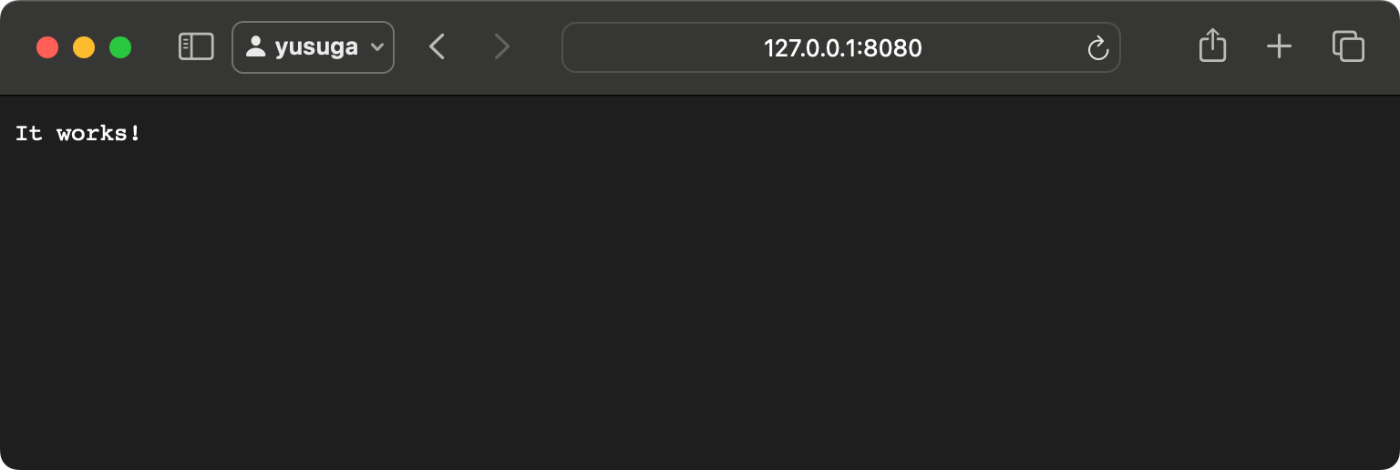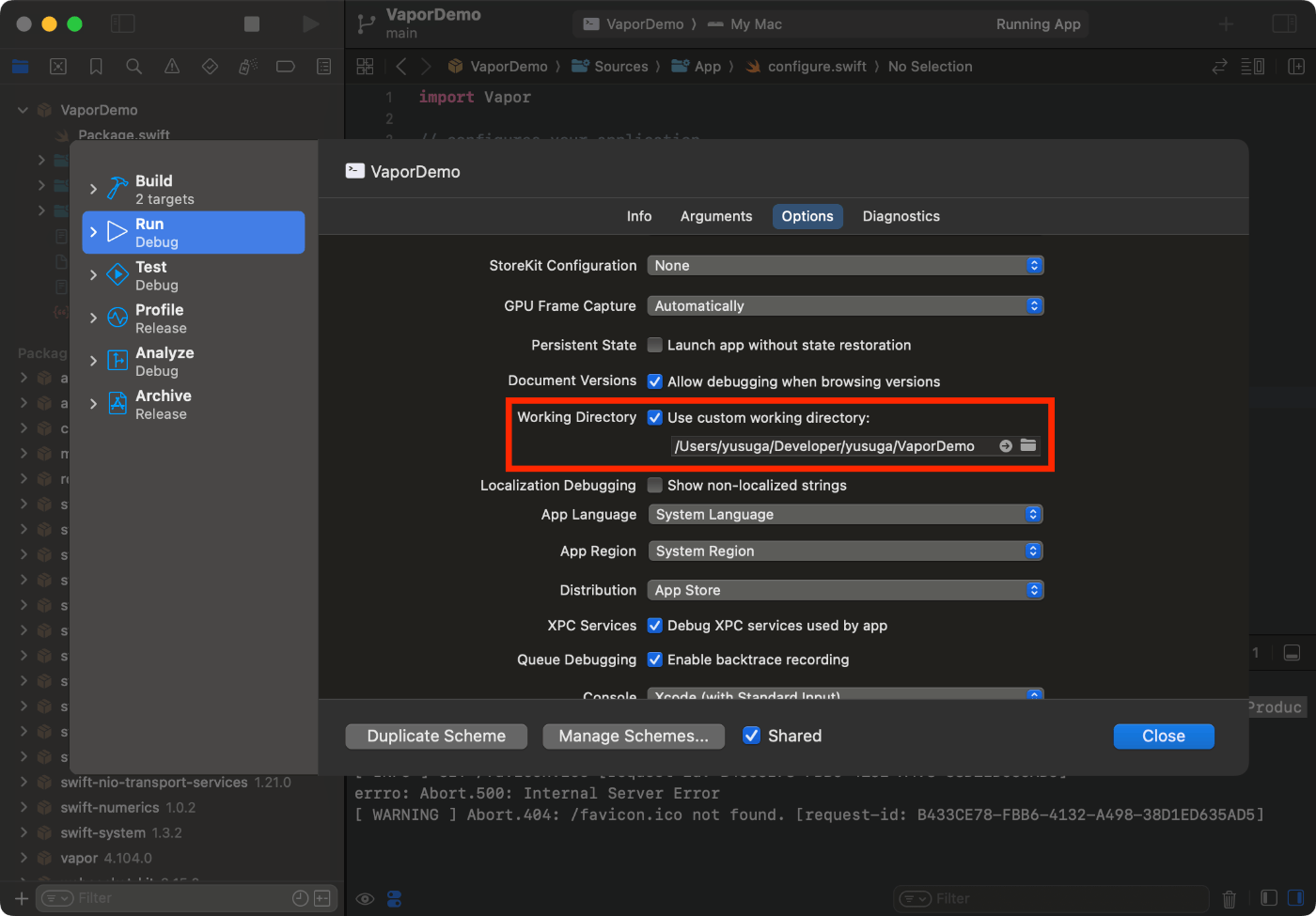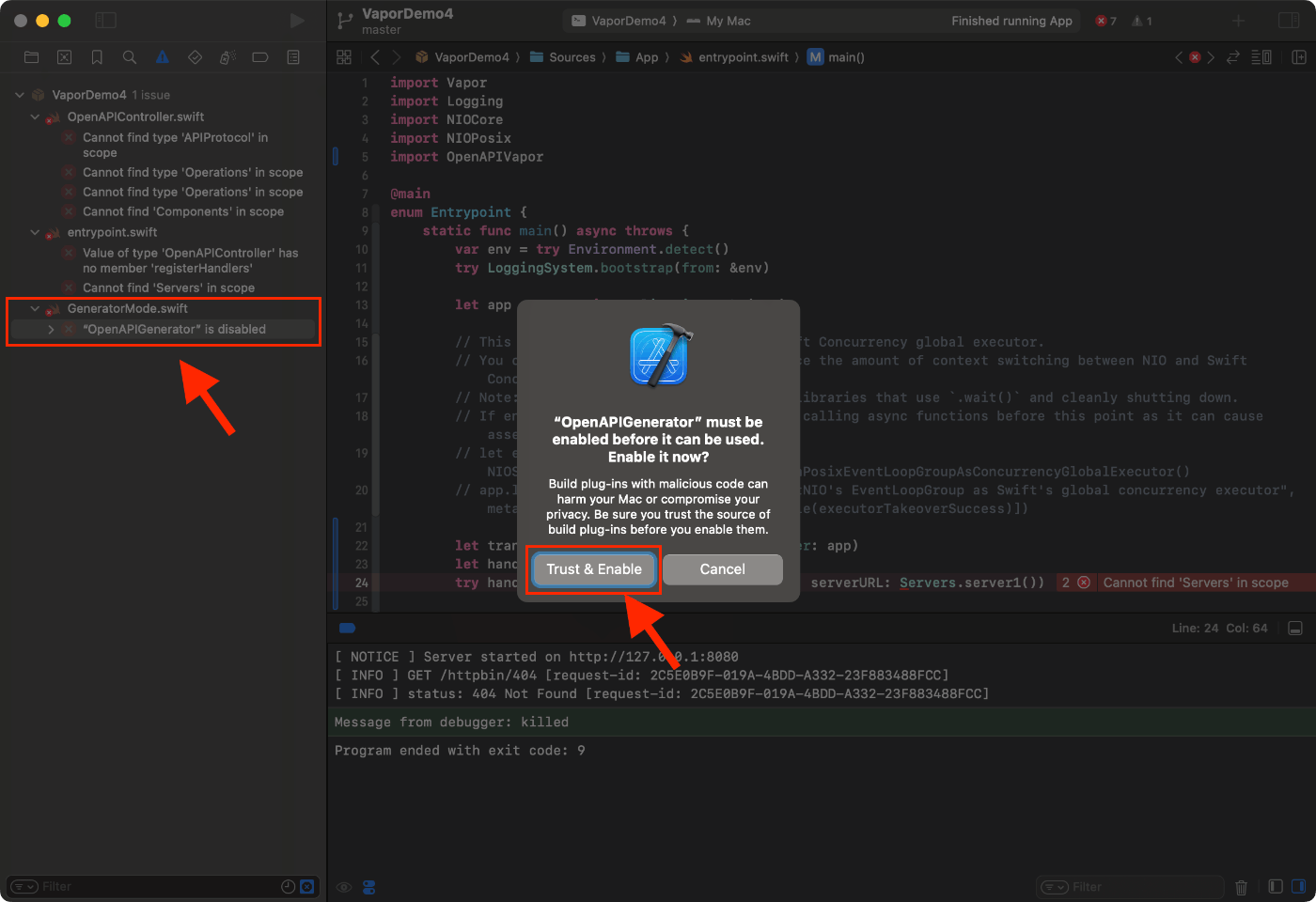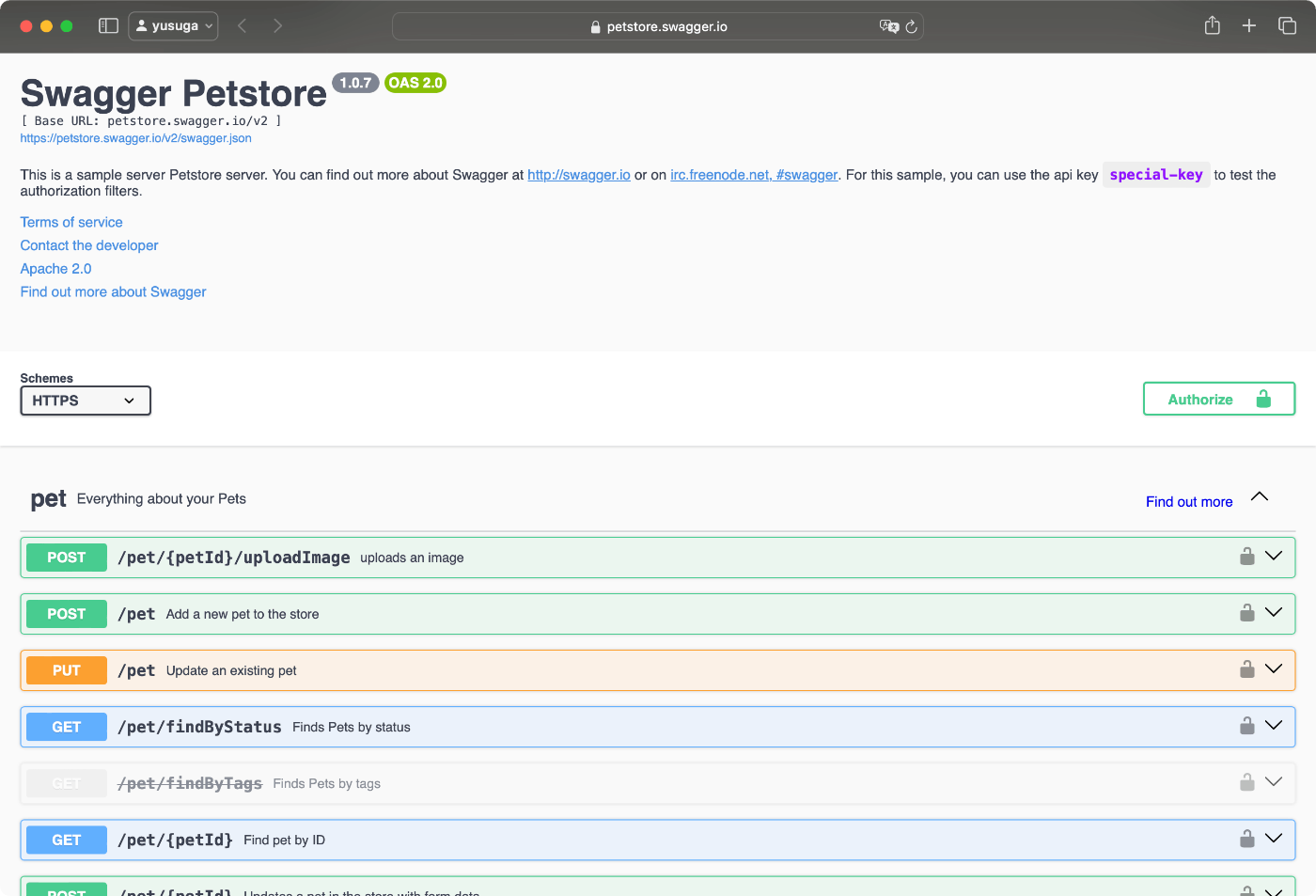2024年から始める Server Side Swift - 第1章 API サーバ構築
Server Side Swift 入門シリーズ
- API サーバ構築 ← いまここ
- Docker 環境を構築(TODO)
- データベースとの連携(TODO)
- クラウド環境を構築 (TODO)
Server Side Swift とは
Swift on Server の内容を引用します。
Swift on Server
概要
Swift は Apple によって開発された汎用プログラミング言語で、元々は iOS や macOS, watchOS, tvOS 向けのアプリケーション開発のために設計されました。しかし、Swift はシステムプログラミングからモバイル、デスクトップアプリケーション、そして分散型のクラウドサービスに至るまで、幅広い用途に対応できるよう設計されています。特にSwiftは、開発者が正確なプログラムを書くことを容易にするように設計されています。
Swift on Server は、Swift 言語をサーバーサイド開発に使用する能力を指します。サーバー上で Swift アプリケーションを展開するためには、Vapor や Hummingbird のような Web フレームワークが利用されます。これらのフレームワークは、ルーティング、データベース統合、リクエスト処理などの重要な機能を提供し、開発者がビジネスロジックの構築に集中できるようサポートします。
なぜ Swift をサーバーで使うのか?
Swift on Server には、サーバーサイドコードを記述するためのモダンで安全かつ効率的な選択肢を提供します。Swift は、ハイレベル言語のシンプルさと読みやすさ、そしてコンパイル言語の性能と安全性を兼ね備えており、開発者はSwiftを使用してエンドツーエンドのソリューションを構築できます。
パフォーマンス
Swift は高速な性能と低いメモリ消費を提供します。自動参照カウント(ARC)を使用してリソースを正確に管理するため、トレースガベージコレクションを行う他の言語と比較して、リソースの利用効率が高くなります。この特性により、Swift はクラウドサービスの分野で強みを発揮します。
高速な起動時間
Swift ベースのアプリケーションは、ほとんどウォームアップ操作を必要としないため、迅速に起動します。このため、Google Cloud Functions や AWS Lambda などのサーバーレスアプリケーションでも優れた適合性を持ち、特に「コールドスタート」時間がほとんどないというメリットがあります。
表現力と安全性
Swift は、型の安全性やオプショナル、メモリの安全性を強制する機能を持っており、プログラミングエラーを防ぎ、コードの信頼性を向上させます。Swift の並行処理モデルはスケーラブルで応答性の高いサーバーアプリケーションの開発に適しています。
サポートされたエコシステム
Swift のエコシステムには、サーバーサイド開発に特化した多くのライブラリやツールが含まれています。これにより、Swift を使用して高速でスケーラブル、かつセキュアなバックエンドサービスを構築する新たな可能性が広がります。
開発ガイドと Swift Server Workgroup
Swift Server Workgroup は、Swift を使ったサーバーアプリケーションの開発と展開を推進するための指導チームです。このワークグループは、Swift サーバーコミュニティのニーズに応えるための取り組みを定義し、優先順位を付けています。
これらの特性により、Swift on Server は現代のクラウドプラットフォームでのリソース効率を最大化するための優れた選択肢となります。
開発方法
Swift 言語は Linux をサポートしています。つまり、Linux 上でのコンパイル、実行、開発が可能であり、Linux で動作するサーバーサイドアプリケーションやコマンドラインツールを生成できます。
Server Side Swift で API サーバーを開発する場合、一般的には Linux 上で API サーバーとして動作する実行可能ファイルを生成することを指します。これには、Vaporなどのフレームワークを使用してAPIエンドポイントを構築し、データベースとの連携やリクエスト処理など、サーバーサイドの全体的なロジックを実装することが含まれます。また、Linux をサポートしているため、Docker コンテナ上で動作させることも可能です。
IDE は iOS 開発と同様に Xcode を使うことも可能ですが、Server Side Swift は Xcode に依存していないため swiftlang/vscode-swift を利用することで VS Code での開発も可能です。
実行方法
ローカル環境
Xcode で Run するとローカルに API サーバが起動するので、 http://localhost:8080 に対してリクエストするとレスポンスが返ってきます。Xcode のデバッガも動いているので、通常の iOS 開発と同様にブレークポイントで止めたり、po などの LLDB のデバッガコマンドも利用可能です。
クラウド環境
一つの方法として、API サーバの実行可能ファイルを含む Docker イメージ(OS、環境設定、依存ライブラリ、アプリケーションの実行可能ファイルなど)を作成します。その Docker イメージを使用して AWS Fargate や GCP の Cloud Run 上で Docker コンテナを起動し、アプリケーションを実行します。
2024年時点での Server Side Swift の最新トレンドを確認
swift.org がおすすめしているライブラリ一覧は https://www.swift.org/packages/server.html です。ここを中心に現時点のトレンドを確認してみます。
サーバーサイドフレームワーク
| ライブラリ | GitHub Star | 最終リリース日 | 特徴 |
|---|---|---|---|
| Vapor | 24,300 | 2024-08-22 | Server Side Swift の代表的なフレームワークで、豊富な機能とエコシステムを持ち、大規模なアプリケーションから小規模な API まで幅広く対応している。日本語ドキュメントあり 読み方: ゔぇいぱー or べーぱー |
| Perfect | 13,800 | 2016-03-22 | リリースがされていないコミットがあるが、2019 年頃以降は大きなアップデートが見られない |
| Kitura | 7,600 | 2022-09-18 | IBM が開発していたが2020年に IBM による開発は終了し、その後は OSS としてメンテされている |
| Smoke | 1,400 | 2024-07-19 | Amazon Prime Video で採用されている |
| Hummingbird | 1,100 | 2024-08-27 | シンプルかつ軽量な設計が特徴で、最小限の依存関係でAPIを構築可能拡張性が高く、小規模なサービスやプロトタイプの開発に向いている |
関連ライブラリ
| OSS | 説明 |
|---|---|
| apple/SwiftNIO | 非同期イベント駆動型のネットワークライブラリで、非同期かつノンブロッキングな I/O もサポート Vapor も依存している基盤技術 |
| apple/swift-openapi-generator | OpenAPI の定義から Swift コードを生成 |
| swift-server/swift-openapi-vapor | swift-openapi-generator が生成したコードを Vapor に組み込むための実装を提供 |
| vapor/Fluent | PostgreSQL, MySQL などをサポートしている ORM |
| vapor/JWTKit | 型安全な JWT |
| vapor/MultipartKit | 型安全な multipart-encoded data |
| apple/Swift Crypto | 一般的な暗号操作 |
| vapor/PostgresNIO | Swift-NIO をベースにした非同期の PostgreSQL クライアント |
| swift-server/RediStack | Swift-NIO をベースにした Redis(インメモリデータベース)クライアント |
結論: Vapor を採用
Vapor は最初期から開発されていたライブラリで、修正ツールも豊富にあります。2024年時点においても Vapor が最有力候補となりそうです。本稿においては Vapor を採用して Server Side Swift の開発を進めていきます。
動作確認環境
- Xcode 16.0
- Vapor 4.99.3
- Vapor 5.0 が発表されましたが、現時点ではまだ採用できないので今回は見送りのちほど対応する
サンプルプロジェクト
完成したプロジェクトはこちらです: https://github.com/yusuga/VaporDemo
macOS で API サーバを起動する
APIサーバは最終的に Linux 上の Docker コンテナで構築しますが、まずはmacOSで構築を試してみます。
Vapor をインストール
$ brew install vapor
インストールが成功したかどうかを --version で確認します。
$ vapor --version
note: no Package.resolved file was found. Possibly not currently in a Swift package directory
framework: Vapor framework for this project: no Package.resolved file found. Please ensure you are in a Vapor project directory. If you are, ensure you have built the project with `swift build`. You can create a new project with `vapor new MyProject`
toolbox: 18.7.5
Vapor のテンプレートからプロジェクトを作成
vapor new VaporDemo -n を実行して、Vapor プロジェクトを作成します。-n をつけることですべての質問が NO になり、最小限の構成で作成できます。
$ vapor new VaporDemo -n
Cloning template...
name: VaporDemo
Would you like to use Fluent (ORM)? (--fluent/--no-fluent)
y/n> no
fluent: No
Would you like to use Leaf (templating)? (--leaf/--no-leaf)
y/n> no
leaf: No
Generating project files
+ Package.swift
+ entrypoint.swift
+ configure.swift
+ routes.swift
+ .gitkeep
+ AppTests.swift
+ .gitkeep
+ Dockerfile
+ docker-compose.yml
+ .gitignore
+ .dockerignore
Creating git repository
Adding first commit
**
**~~**
**~~~~~~**
**~~~~~~~~~~**
**~~~~~~~~~~~~~~**
**~~~~~~~~~~~~~~~~~~**
**~~~~~~~~~~~~~~~~~~~~~~**
**~~~~~~~~~~~~~~~~~~~~~~~~**
**~~~~~~~~~~~~~~~~~~~~~~~~~~**
**~~~~~~~~~~~~~~~~~~~~~~~~~~~~**
**~~~~~~~~~~~~~~~~~~~~~~~~~~~~**
**~~~~~~~~~~~~~~~~~~~~~++++~~~**
**~~~~~~~~~~~~~~~~~~~++++~~~**
***~~~~~~~~~~~~~~~++++~~~***
****~~~~~~~~~~++++~~****
*****~~~~~~~~~*****
*************
_ __ ___ ___ ___
\ \ / / /\ | |_) / / \ | |_)
\_\/ /_/--\ |_| \_\_/ |_| \
a web framework for Swift
Project VaporDemo has been created!
Use cd 'VaporDemo' to enter the project directory
Then open your project, for example if using Xcode type open Package.swift or code . if using VSCode
API サーバを起動
テンプレートから作成したプロジェクト内にある Package.swift を Xcode で開きます。
$ cd VaporDemo
$ open Package.swift
Xcode で Target を My Mac にして Run すると、コンソールに次のログが表示されます。
[ INFO ] Server starting on http://127.0.0.1:8080
ブラウザで http://127.0.0.1:8080 を開きます。It works! と表示されればサーバの起動に成功しています。

API サーバを開発
ルーティング
デフォルトのルーティングのコードは Sources/App/routes.swift に定義されています。http://127.0.0.1:8080 にアクセスすると It works! と表示されているのも、routes メソッドが実装されているからです。
func routes(_ app: Application) throws {
app.get { req async in
"It works!"
}
app.get("hello") { req async -> String in
"Hello, world!"
}
}
試しに http://127.0.0.1:8080/hello にアクセスすると Hello, world! が表示されるのが確認できます。
公開ファイルへのアクセス
画像ファイルを追加
表示したい画像を Public ディレクトリ内に追加します(仮に sample.jpg とします)。
Sources/App/configure.swift の configure(_:) 関数に FileMiddleware を追加します。
public func configure(_ app: Application) async throws {
// Serves files from `Public/` directory
app.middleware.use(
FileMiddleware(
publicDirectory: app.directory.publicDirectory
)
)
// register routes
try routes(app)
}
[重要] Xcode の Working directory を変更
Xcode で開発する場合には scheme から Working directory(作業ディレクトリ)をプロジェクトのルートディレクトリに変更する必要があります。


ブラウザで http://127.0.0.1:8080/sample.jpg にアクセスすると画像が表示されることを確認できます。
画像を返す
すでに Public ディレクトリに sample.jpg を置いているので http://127.0.0.1:8080/sample.jpg でアクセス可能ですが、 http://127.0.0.1:8080/image にアクセスした時にも画像が返るようにしてみます。
routes(_:) 関数に新たなエンドポイントを追加します。
func routes(_ app: Application) throws {
// <中略>
app.get("image") { request async throws in
// public ディレクトリ内にある画像へのパスを取得
let path = app.directory.publicDirectory.appending("sample.jpg")
// 指定したパスの ByteBuffer を取得
let buffer = try await request.fileio.collectFile(at: path)
var headers = HTTPHeaders()
headers.contentType = .jpeg
return Response(
status: .ok,
headers: headers,
body: .init(buffer: buffer)
)
}
}
http://127.0.0.1:8080/image にアクセスすると画像が表示されることを確認できます。
JSON を返す
JSON を返すエンドポイントを追加します。
func routes(_ app: Application) throws {
// <中略>
app.get("json") { _ in
let json = [
"message": "Hello, Vapor!",
"status": "success"
]
let response = Response(status: .ok)
try response.content.encode(json, as: .json)
return response
}
}
ブラウザでも確認可能ですが、今回は curl コマンドで動作確認を行ってみます。
curl コマンドは、様々な通信プロトコルでデータの送受信を行うことができるコマンドで、macOS にはプリインストールされているため、追加インストール不要でそのままコンソールで使用可能です。
-v をオプションをつけるとリクエストとレスポンスの詳細情報が表示されます。
$ curl -v http://127.0.0.1:8080/json
* Trying 127.0.0.1:8080...
* Connected to 127.0.0.1 (127.0.0.1) port 8080
> GET /json HTTP/1.1
> Host: 127.0.0.1:8080
> User-Agent: curl/8.6.0
> Accept: */*
>
< HTTP/1.1 200 OK
< content-type: application/json; charset=utf-8
< content-length: 46
< connection: keep-alive
< date: Thu, 26 Sep 2024 19:39:00 GMT
<
* Connection #0 to host 127.0.0.1 left intact
{"message":"Hello, Vapor!","status":"success"}%
EventLoopFuture vs async/await
Vapor 4 では、各メソッドに EventLoopFuture を返すものと、async/await に対応したものの2種類が定義されています。EventLoopFuture は、async/await が導入される以前の非同期処理手法です。現在、多くのVaporのメソッドは async/await に対応しており、どちらを使用するかは開発者が選択可能です。
async/await の方がコードの可読性が高い一方で、EventLoopFuture ではイベントループ(非同期タスクを処理するスレッドやキュー)を直接操作できるという利点があります。これにより、タスクの処理やスケジューリングをより細かく制御できるため、細かな調整が必要な場面では EventLoopFuture の方が優れています。
ただし、Swift 5.9 で導入された SE-0392: Custom Actor Executors により、async/await でも同様の細かな制御が可能となったため、現在は async/await を優先的に使用しても問題ありません。
さらに、Vapor 5 では EventLoopFuture は削除される予定であるため、将来を見据えても async/await を使用することが推奨されます。
Controller の活用
URI を階層的に構造化する場合にはパスセグメントを使用します。URIのパスセグメントは、リソースの階層的な場所を指定する部分です。スラッシュで区切られた各部分が階層を表し、サーバー上の特定のリソースにアクセスするために使われます。
ここまでで実装した image と json を http://127.0.0.1:8080/my 以下からでもアクセス可能にするために、新たに MyController.swift を定義します。
import Vapor
struct MyController: RouteCollection {
func boot(routes: RoutesBuilder) throws {
// パスセグメントを定義
let myRoutes = routes.grouped("my")
// パスと処理を行うメソッドを登録
myRoutes.get("image", use: getImage)
myRoutes.get("json", use: getJSON)
}
@Sendable
func getImage(request: Request) async throws -> Response {
// Public ディレクトリ内にある画像へのパスを取得
// ※ routes.swift からの差分で app へのアクセスが request.application に変わります
let path = request.application.directory.publicDirectory.appending("sample.jpg")
// 指定したパスの ByteBuffer を取得
let buffer = try await request.fileio.collectFile(at: path)
var headers = HTTPHeaders()
headers.contentType = .jpeg
return Response(
status: .ok,
headers: headers,
body: .init(buffer: buffer)
)
}
@Sendable
func getJSON(request: Request) throws -> Response {
let json = [
"message": "Hello, Vapor!",
"status": "success"
]
let response = Response(status: .ok)
try response.content.encode(json, as: .json)
return response
}
}
routes(_:) 関数にコントローラの登録を追加します。
func routes(_ app: Application) throws {
// <中略>
try app.register(collection: MyController())
}
これで http://127.0.0.1:8080/my/json と http://127.0.0.1:8080/my/image にアクセスが可能になります。
カスタムしたエラーを返す
画像を取得するために使用していた request.fileio.collectFile(at:) は存在しないリソースにアクセスするとエラーを throw します。
どんなエラーを throw するかを確認するために MyController へ新しいエンドポイントで notfound-500 を追加します。
struct MyController: RouteCollection {
// <中略>
@Sendable
func notFound500(request: Request) async throws -> Response {
let image = try await request.fileio.collectFile(
at: request.application.directory.publicDirectory
.appending("not_found_image.jpg")
)
return Response(status: .ok)
}
}
notfound-500 のパスを登録します。
struct MyController: RouteCollection {
func boot(routes: RoutesBuilder) throws {
// <中略>
myRoutes.get("notfound-500", use: notFound500)
}
// <中略>
}
curl でリクエストすると HTTP Status が 500 でデフォルトのエラーレスポンスが返されることを確認できます。
curl -v http://127.0.0.1:8080/my/notfound-500
* Trying 127.0.0.1:8080...
* Connected to 127.0.0.1 (127.0.0.1) port 8080
> GET /my/not-found-500 HTTP/1.1
> Host: 127.0.0.1:8080
> User-Agent: curl/8.6.0
> Accept: */*
>
< HTTP/1.1 500 Internal Server Error
< content-type: application/json; charset=utf-8
< content-length: 47
< connection: keep-alive
< date: Thu, 26 Sep 2024 20:37:39 GMT
<
* Connection #0 to host 127.0.0.1 left intact
{"error":true,"reason":"Internal Server Error"}%
カスタムしたエラーを返すのを試すために新たエンドポイントで notfound を追加します。
do-catch をして Abort を throw することでカスタムしたエラーを返すことができます。
struct MyController: RouteCollection {
func boot(routes: RoutesBuilder) throws {
// <中略>
myRoutes.get("notfound", use: notFound)
}
// <中略>
@Sendable
func notFound(request: Request) async throws -> Response {
do {
let _ = try await request.fileio.collectFile(
at: request.application.directory.publicDirectory.appending("not_found_image.jpg")
)
return Response(status: .ok)
} catch {
// 任意のエラーを throw する
throw Abort(.notFound, reason: "Not found Request")
}
}
}
curl で HTTP Status が 404 のエラーレスポンスが返されることを確認できます。
curl -v http://127.0.0.1:8080/my/notfound
* Trying 127.0.0.1:8080...
* Connected to 127.0.0.1 (127.0.0.1) port 8080
> GET /my/notfound HTTP/1.1
> Host: 127.0.0.1:8080
> User-Agent: curl/8.6.0
> Accept: */*
>
< HTTP/1.1 404 Not Found
< content-type: application/json; charset=utf-8
< content-length: 43
< connection: keep-alive
< date: Thu, 26 Sep 2024 20:46:54 GMT
<
* Connection #0 to host 127.0.0.1 left intact
{"reason":"Not found Request","error":true}%
サーバーから別のサーバーにリクエスト
サーバからさらに別にサーバに対してリクエストをし、そのレスポンスを返してみます。
例として https://httpbin.org を使用してみます。httpbin.org は、HTTP リクエストをテストするための無料の Web サービスです。ユーザーがさまざまな HTTP メソッド(GET、POST、PUT、DELETE など)を使用してリクエストを送信し、その結果を確認できるツールです。主に HTTP クライアントのテストやデバッグに使用され、返されるレスポンスには、送信されたリクエストヘッダーやボディ、クエリパラメータなどが含まれます。
まずは curl で確認してみます。
$ curl -v https://httpbin.org/get
Note: Unnecessary use of -X or --request, GET is already inferred.
* Host httpbin.org:443 was resolved.
* IPv6: (none)
* IPv4: 34.234.145.214, 35.173.87.161
* Trying 34.234.145.214:443...
* Connected to httpbin.org (34.234.145.214) port 443
* ALPN: curl offers h2,http/1.1
* (304) (OUT), TLS handshake, Client hello (1):
* CAfile: /etc/ssl/cert.pem
* CApath: none
* (304) (IN), TLS handshake, Server hello (2):
* TLSv1.2 (IN), TLS handshake, Certificate (11):
* TLSv1.2 (IN), TLS handshake, Server key exchange (12):
* TLSv1.2 (IN), TLS handshake, Server finished (14):
* TLSv1.2 (OUT), TLS handshake, Client key exchange (16):
* TLSv1.2 (OUT), TLS change cipher, Change cipher spec (1):
* TLSv1.2 (OUT), TLS handshake, Finished (20):
* TLSv1.2 (IN), TLS change cipher, Change cipher spec (1):
* TLSv1.2 (IN), TLS handshake, Finished (20):
* SSL connection using TLSv1.2 / ECDHE-RSA-AES128-GCM-SHA256 / [blank] / UNDEF
* ALPN: server accepted h2
* Server certificate:
* subject: CN=httpbin.org
* start date: Aug 20 00:00:00 2024 GMT
* expire date: Sep 17 23:59:59 2025 GMT
* subjectAltName: host "httpbin.org" matched cert's "httpbin.org"
* issuer: C=US; O=Amazon; CN=Amazon RSA 2048 M02
* SSL certificate verify ok.
* using HTTP/2
* [HTTP/2] [1] OPENED stream for https://httpbin.org/get
* [HTTP/2] [1] [:method: GET]
* [HTTP/2] [1] [:scheme: https]
* [HTTP/2] [1] [:authority: httpbin.org]
* [HTTP/2] [1] [:path: /get]
* [HTTP/2] [1] [user-agent: curl/8.6.0]
* [HTTP/2] [1] [accept: */*]
> GET /get HTTP/2
> Host: httpbin.org
> User-Agent: curl/8.6.0
> Accept: */*
>
< HTTP/2 200
< date: Thu, 26 Sep 2024 20:50:48 GMT
< content-type: application/json
< content-length: 255
< server: gunicorn/19.9.0
< access-control-allow-origin: *
< access-control-allow-credentials: true
<
{
"args": {},
"headers": {
"Accept": "*/*",
"Host": "httpbin.org",
"User-Agent": "curl/8.6.0",
"X-Amzn-Trace-Id": "Root=1-66f5c927-6687801e6e16058f39518ef0"
},
"origin": "210.199.185.33",
"url": "https://httpbin.org/get"
}
* Connection #0 to host httpbin.org left intact
Controllers に新たに HTTPBinController を定義します。今回は httpbin の結果をそのままレスポンスとして返します。
import Vapor
struct HTTPBinController: RouteCollection {
func boot(routes: any Vapor.RoutesBuilder) throws {
let myRoutes = routes.grouped("httpbin")
myRoutes.get("get", use: get)
}
@Sendable
func get(request: Request) async throws -> ClientResponse {
try await request.client.get("https://httpbin.org/get")
}
}
routes(_:) 関数にコントローラを登録します。
func routes(_ app: Application) throws {
// <中略>
try app.register(collection: HTTPBinController())
}
curl で httpbin のレスポンスが返ることを確認できます。
$ curl -v http://127.0.0.1:8080/httpbin/get
* Trying 127.0.0.1:8080...
* Connected to 127.0.0.1 (127.0.0.1) port 8080
> GET /httpbin/get HTTP/1.1
> Host: 127.0.0.1:8080
> User-Agent: curl/8.6.0
> Accept: */*
>
< HTTP/1.1 200 OK
< date: Thu, 26 Sep 2024 20:54:59 GMT
< content-type: application/json
< content-length: 200
< server: gunicorn/19.9.0
< access-control-allow-origin: *
< access-control-allow-credentials: true
< connection: keep-alive
< date: Thu, 26 Sep 2024 20:54:59 GMT
<
{
"args": {},
"headers": {
"Host": "httpbin.org",
"X-Amzn-Trace-Id": "Root=1-66f5ca22-70e6bf2e59af4f96178eafd1"
},
"origin": "210.199.185.33",
"url": "https://httpbin.org/get"
}
* Connection #0 to host 127.0.0.1 left intact
次に、別サーバからエラーを返ってくるケースを確認します。httpbin はエラー系のステータスコードを返すエンドポイントがあり、 https://httpbin.org/status/404 で 404 が返ってきます。
curl -v https://httpbin.org/status/404
* Host httpbin.org:443 was resolved.
* IPv6: (none)
* IPv4: 34.234.145.214, 35.173.87.161
* Trying 34.234.145.214:443...
* Connected to httpbin.org (34.234.145.214) port 443
* ALPN: curl offers h2,http/1.1
* (304) (OUT), TLS handshake, Client hello (1):
* CAfile: /etc/ssl/cert.pem
* CApath: none
* (304) (IN), TLS handshake, Server hello (2):
* TLSv1.2 (IN), TLS handshake, Certificate (11):
* TLSv1.2 (IN), TLS handshake, Server key exchange (12):
* TLSv1.2 (IN), TLS handshake, Server finished (14):
* TLSv1.2 (OUT), TLS handshake, Client key exchange (16):
* TLSv1.2 (OUT), TLS change cipher, Change cipher spec (1):
* TLSv1.2 (OUT), TLS handshake, Finished (20):
* TLSv1.2 (IN), TLS change cipher, Change cipher spec (1):
* TLSv1.2 (IN), TLS handshake, Finished (20):
* SSL connection using TLSv1.2 / ECDHE-RSA-AES128-GCM-SHA256 / [blank] / UNDEF
* ALPN: server accepted h2
* Server certificate:
* subject: CN=httpbin.org
* start date: Aug 20 00:00:00 2024 GMT
* expire date: Sep 17 23:59:59 2025 GMT
* subjectAltName: host "httpbin.org" matched cert's "httpbin.org"
* issuer: C=US; O=Amazon; CN=Amazon RSA 2048 M02
* SSL certificate verify ok.
* using HTTP/2
* [HTTP/2] [1] OPENED stream for https://httpbin.org/status/404
* [HTTP/2] [1] [:method: GET]
* [HTTP/2] [1] [:scheme: https]
* [HTTP/2] [1] [:authority: httpbin.org]
* [HTTP/2] [1] [:path: /status/404]
* [HTTP/2] [1] [user-agent: curl/8.6.0]
* [HTTP/2] [1] [accept: */*]
> GET /status/404 HTTP/2
> Host: httpbin.org
> User-Agent: curl/8.6.0
> Accept: */*
>
< HTTP/2 404
< date: Thu, 26 Sep 2024 20:57:08 GMT
< content-type: text/html; charset=utf-8
< content-length: 0
< server: gunicorn/19.9.0
< access-control-allow-origin: *
< access-control-allow-credentials: true
<
* Connection #0 to host httpbin.org left intact
HTTPBinController に getStatus404(request:) 関数を追加します。
struct HTTPBinController: RouteCollection {
func boot(routes: any Vapor.RoutesBuilder) throws {
// <中略>
myRoutes.get("404", use: getStatus404)
}
// <中略>
@Sendable
func getStatus404(request: Request) async throws -> ClientResponse {
let response = try await request.client.get("https://httpbin.org/status/404")
request.logger.info("status: \(response.status)") // 404 Not Found
return response
}
}
curl で httpbin が返したら 404 がそのまま返されることを確認できます。
$ curl -v http://127.0.0.1:8080/httpbin/404
* Trying 127.0.0.1:8080...
* Connected to 127.0.0.1 (127.0.0.1) port 8080
> GET /httpbin/404 HTTP/1.1
> Host: 127.0.0.1:8080
> User-Agent: curl/8.6.0
> Accept: */*
>
< HTTP/1.1 404 Not Found
< date: Thu, 26 Sep 2024 20:58:59 GMT
< content-type: text/html; charset=utf-8
< content-length: 0
< server: gunicorn/19.9.0
< access-control-allow-origin: *
< access-control-allow-credentials: true
< connection: keep-alive
< date: Thu, 26 Sep 2024 20:58:59 GMT
<
* Connection #0 to host 127.0.0.1 left intact
OpenAPI の導入
エンドポイントの実装を型安全にする目的で OpenAPI を導入してみます。
OpenAPI とは、RESTful API を設計・記述するための標準仕様です。この仕様に従うことで、API のエンドポイント、リクエストやレスポンスの形式、認証方法などを統一的に記述することができ、API の利用者にとって理解しやすくなります。
openapi.yaml ファイルを Sources/App 配下に追加します。
openapi: '3.1.0'
info:
title: GreetingService
version: 1.0.0
servers:
- url: http://127.0.0.1/openapi
description: Example service deployment.
paths:
/greet:
get:
operationId: getGreeting
parameters:
- name: name
required: false
in: query
description: The name used in the returned greeting.
schema:
type: string
responses:
'200':
description: A success response with a greeting.
content:
application/json:
schema:
$ref: '#/components/schemas/Greeting'
components:
schemas:
Greeting:
type: object
properties:
message:
type: string
required:
- message
openapi-generator-config.yaml ファイルを Sources/App 配下に追加します。
generate:
- types
- server
openapi.yaml の定義から Swift コードを生成するために apple/swift-openapi-generator を使用します。
Package.swift に swift-openapi-generator 関係の依存と Plugin を追加します。
git diff Package.swift
diff --git a/Package.swift b/Package.swift
index 95a9aa4..65382ea 100644
--- a/Package.swift
+++ b/Package.swift
@@ -11,16 +11,29 @@ let package = Package(
.package(url: "https://github.com/vapor/vapor.git", from: "4.99.3"),
// 🔵 Non-blocking, event-driven networking for Swift. Used for custom executors
.package(url: "https://github.com/apple/swift-nio.git", from: "2.65.0"),
+
+ // OpenAPI
+ .package(url: "https://github.com/apple/swift-openapi-generator", from: "1.3.0"),
+ .package(url: "https://github.com/apple/swift-openapi-runtime", from: "1.5.0"),
+ .package(url: "https://github.com/swift-server/swift-openapi-vapor", from: "1.0.1"),
],
targets: [
.executableTarget(
name: "App",
dependencies: [
+ // Vapor
.product(name: "Vapor", package: "vapor"),
.product(name: "NIOCore", package: "swift-nio"),
.product(name: "NIOPosix", package: "swift-nio"),
+
+ // OpenAPI
+ .product(name: "OpenAPIRuntime", package: "swift-openapi-runtime"),
+ .product(name: "OpenAPIVapor", package: "swift-openapi-vapor"),
],
- swiftSettings: swiftSettings
+ swiftSettings: swiftSettings,
+ plugins: [
+ .plugin(name: "OpenAPIGenerator", package: "swift-openapi-generator"),
+ ]
),
.testTarget(
name: "AppTests",
コントローラに OpenAPIController を追加します。
import OpenAPIRuntime
import OpenAPIVapor
struct OpenAPIController: APIProtocol {
func getGreeting(
_ input: Operations.getGreeting.Input
) async throws -> Operations.getGreeting.Output {
let name = input.query.name ?? "Stranger"
let greeting = Components.Schemas.Greeting(message: "Hello, \(name)!")
return .ok(.init(body: .json(greeting)))
}
}
Sources/App/entrypoint.swift に handler.registerHandlers(on:serverURL:) を追加します。
git diff Sources/App/entrypoint.swift
diff --git a/Sources/App/entrypoint.swift b/Sources/App/entrypoint.swift
index 318b17f..1ca4748 100644
--- a/Sources/App/entrypoint.swift
+++ b/Sources/App/entrypoint.swift
@@ -2,6 +2,7 @@ import Vapor
import Logging
import NIOCore
import NIOPosix
+import OpenAPIVapor
@main
enum Entrypoint {
@@ -18,6 +19,11 @@ enum Entrypoint {
// let executorTakeoverSuccess = NIOSingletons.unsafeTryInstallSingletonPosixEventLoopGroupAsConcurrencyGlobalExecutor()
// app.logger.debug("Tried to install SwiftNIO's EventLoopGroup as Swift's global concurrency executor", metadata: ["success": .stringConvertible(executorTakeoverSuccess)])
+
+ let transport = VaporTransport(routesBuilder: app)
+ let handler = OpenAPIController()
+ try handler.registerHandlers(on: transport, serverURL: Servers.server1())
+
do {
try await configure(app)
} catch {
ビルドすると初回はビルドエラーが発生します。いくつか発生したビルドエラーの中にある "OpenAPIGEnerator" is disabled をクリックしてください。これは OpenAPIGenerator が Build Plugin で動作して openapi.yaml から Swift コードを生成するのですが、Xcode 16.0 時点での仕様では、Build Plugin を動作するための許可を明示的に行う必要があります。

Build Plugin を許可した後に再度 Run をするとビルドが成功します。
これで curl で http://127.0.0.1:8080/openapi/greet?name=Ja に対してリクエストを送れることが確認できます。
$ curl -v 'http://127.0.0.1:8080/openapi/greet?name=Jane'
* Trying 127.0.0.1:8080...
* Connected to 127.0.0.1 (127.0.0.1) port 8080
> GET /openapi/greet?name=Jane HTTP/1.1
> Host: 127.0.0.1:8080
> User-Agent: curl/8.6.0
> Accept: */*
>
< HTTP/1.1 200 OK
< Content-Type: application/json; charset=utf-8
< content-length: 32
< connection: keep-alive
< date: Thu, 26 Sep 2024 21:29:20 GMT
<
{
"message" : "Hello, Jane!"
* Connection #0 to host 127.0.0.1 left intact
}%
swift-openapi-generator が生成しているコードは APIProtocol の実装に飛ぶと確認できます。生成されるコードにはパス、クエリパラメータ、レスポンスボディの型、Content-Type などが含まれています。
これで openapi.yaml の定義を更新することで、ビルド時に新しい定義を元に APIProtocol が再生成さるため、もしも新たなエンドポイントを追加したり、クエリパラメータやレスポンスボディの定義が変わったらビルドエラーになり、定義と実装の不一致に機械的に気づくことができます。
APIProtocol から Request へアクセスする
コードが自動生成されることによって実装は楽になりましたが、APIProtocol は Vapor の Request にアクセスする方法が提供されていないため、request.client.get("https://httpbin.org/get") や request.fileio.collectFile(at:) のような実装ができなくなりました。
そこで swift-dependencies を使って Request を DI(依存性注入)することで Request にアクセスできるようにします。
Package.swift に swift-dependencies を追加します。
git diff Package.swift
diff --git a/Package.swift b/Package.swift
index 95a9aa4..47424e6 100644
--- a/Package.swift
+++ b/Package.swift
@@ -11,16 +11,35 @@ let package = Package(
.package(url: "https://github.com/vapor/vapor.git", from: "4.99.3"),
// 🔵 Non-blocking, event-driven networking for Swift. Used for custom executors
.package(url: "https://github.com/apple/swift-nio.git", from: "2.65.0"),
// OpenAPI
.package(url: "https://github.com/apple/swift-openapi-generator", from: "1.3.0"),
.package(url: "https://github.com/apple/swift-openapi-runtime", from: "1.5.0"),
.package(url: "https://github.com/swift-server/swift-openapi-vapor", from: "1.0.1"),
+ // DI
+ .package(url: "https://github.com/pointfreeco/swift-dependencies", from: "1.3.9"),
],
targets: [
.executableTarget(
name: "App",
dependencies: [
// Vapor
.product(name: "Vapor", package: "vapor"),
.product(name: "NIOCore", package: "swift-nio"),
.product(name: "NIOPosix", package: "swift-nio"),
// OpenAPI
.product(name: "OpenAPIRuntime", package: "swift-openapi-runtime"),
.product(name: "OpenAPIVapor", package: "swift-openapi-vapor"),
+ // DI
+ .product(name: "Dependencies", package: "swift-dependencies"),
],
Sources/App/Extensions ディレクトリを新たに作成して、その中に DependencyValues+App.swift を定義します。ちょっと変わった設計ですが、リクエストごとに DI されるため、 liveValue が存在しない設計になります。
import Dependencies
import Vapor
extension DependencyValues {
var request: Request {
get { self[RequestKey.self] }
set { self[RequestKey.self] = newValue }
}
private enum RequestKey: DependencyKey {
static var liveValue: Request {
fatalError("Value of type \(Value.self) is not registered in this context")
}
}
}
Sources/App/Middleware ディレクトリを新たに作成して、その中に OpenAPIRequestInjectionMiddleware.swift を定義します。このミドルウェアでエンドポイントを処理するたびに Request を DI します。
import Dependencies
import Vapor
struct OpenAPIRequestInjectionMiddleware: AsyncMiddleware {
func respond(
to request: Request,
chainingTo responder: AsyncResponder
) async throws -> Response {
try await withDependencies {
$0.request = request
} operation: {
try await responder.respond(to: request)
}
}
}
Sources/App/entrypoint.swift の main メソッド内で OpenAPIRequestInjectionMiddleware を VaporTransport に追加します。
enum Entrypoint {
static func main() async throws {
var env = try Environment.detect()
try LoggingSystem.bootstrap(from: &env)
let app = try await Application.make(env)
// This attempts to install NIO as the Swift Concurrency global executor.
// You can enable it if you'd like to reduce the amount of context switching between NIO and Swift Concurrency.
// Note: this has caused issues with some libraries that use `.wait()` and cleanly shutting down.
// If enabled, you should be careful about calling async functions before this point as it can cause assertion failures.
// let executorTakeoverSuccess = NIOSingletons.unsafeTryInstallSingletonPosixEventLoopGroupAsConcurrencyGlobalExecutor()
// app.logger.debug("Tried to install SwiftNIO's EventLoopGroup as Swift's global concurrency executor", metadata: ["success": .stringConvertible(executorTakeoverSuccess)])
+ let requestInjectionMiddleware = OpenAPIRequestInjectionMiddleware()
- let transport = VaporTransport(routesBuilder: app)
+ let transport = VaporTransport(routesBuilder: app.grouped(requestInjectionMiddleware))
let handler = OpenAPIController()
try handler.registerHandlers(on: transport, serverURL: Servers.server1())
OpenAPIController に @Dependency(\.request) var request を追加します。
git diff Sources/App/Controllers/OpenAPIController.swift
diff --git a/Sources/App/Controllers/OpenAPIController.swift b/Sources/App/Controllers/OpenAPIController.swift
index 9e40cce..6318adb 100644
--- a/Sources/App/Controllers/OpenAPIController.swift
+++ b/Sources/App/Controllers/OpenAPIController.swift
@@ -1,8 +1,11 @@
import OpenAPIRuntime
import OpenAPIVapor
+import Dependencies
struct OpenAPIController: APIProtocol {
+ @Dependency(\.request) var request
+
func getGreeting(
_ input: Operations.getGreeting.Input
) async throws -> Operations.getGreeting.Output {
openapi.yaml を MyController で実装していた image と json に書き換えます。
openapi: '3.1.0'
info:
title: GreetingService
version: 1.0.0
servers:
- url: http://127.0.0.1/openapi
description: Example service deployment.
paths:
/image:
get:
operationId: getImage
responses:
'200':
description: A Cat image.
content:
image/jpeg:
schema:
type: string
format: binary
/json:
get:
operationId: getJSON
responses:
'200':
description: A JSON.
content:
application/json:
schema:
$ref: '#/components/schemas/HelloVapor'
components:
schemas:
HelloVapor:
type: object
properties:
message:
type: string
status:
type: string
required:
- message
- status
ここでビルドすると OpenAPIController に getImage と getJSON の実装がないためビルドエラーになります。新しい APIProtocol の実装に合わせて OpenAPIController を改修します。
import OpenAPIRuntime
import OpenAPIVapor
import Dependencies
import Vapor
struct OpenAPIController: APIProtocol {
@Dependency(\.request) var request
func getImage(_ input: Operations.getImage.Input) async throws -> Operations.getImage.Output {
// Public ディレクトリ内にある画像へのパスを取得
let path = request.application.directory.publicDirectory.appending("sample.jpg")
// 指定したパスの ByteBuffer を取得
var buffer = try await request.fileio.collectFile(at: path)
// 最終的に返す `Operations.getImage.OutPut.OK.Body.jpeg` は
// `OpenAPIRuntime.HTTPBody` を求めているため、ByteBuffer から Data を生成する
guard let data = buffer.readData(
length: buffer.readableBytes,
byteTransferStrategy: .noCopy
) else {
throw Abort(.badRequest)
}
// 型安全に返せる
return .ok(
.init(
body: .jpeg(
.init(data)
)
)
)
}
func getJSON(_ input: Operations.getJSON.Input) async throws -> Operations.getJSON.Output {
// 型安全に返せる
.ok(
.init(
body: .json(
.init(
message: "Hello, Vapor!",
status: "success"
)
)
)
)
}
}
http://127.0.0.1:8080/openapi/image で、メソッド内で適切に Request にアクセスできて画像のバイナリが返ってくることが確認できます。
$ curl -v http://127.0.0.1:8080/openapi/image > /dev/null
% Total % Received % Xferd Average Speed Time Time Time Current
Dload Upload Total Spent Left Speed
0 0 0 0 0 0 0 0 --:--:-- --:--:-- --:--:-- 0* Trying 127.0.0.1:8080...
* Connected to 127.0.0.1 (127.0.0.1) port 8080
> GET /openapi/image HTTP/1.1
> Host: 127.0.0.1:8080
> User-Agent: curl/8.6.0
> Accept: */*
>
< HTTP/1.1 200 OK
< Content-Type: image/jpeg
< content-length: 62102
< connection: keep-alive
< date: Thu, 26 Sep 2024 22:24:00 GMT
<
{ [62102 bytes data]
100 62102 100 62102 0 0 9769k 0 --:--:-- --:--:-- --:--:-- 9.8M
* Connection #0 to host 127.0.0.1 left intact
http://127.0.0.1:8080/openapi/json も JSON が返ることを確認できます。
curl -v http://127.0.0.1:8080/openapi/json
* Trying 127.0.0.1:8080...
* Connected to 127.0.0.1 (127.0.0.1) port 8080
> GET /openapi/json HTTP/1.1
> Host: 127.0.0.1:8080
> User-Agent: curl/8.6.0
> Accept: */*
>
< HTTP/1.1 200 OK
< Content-Type: application/json; charset=utf-8
< content-length: 57
< connection: keep-alive
< date: Thu, 26 Sep 2024 22:31:27 GMT
<
{
"message" : "Hello, Vapor!",
"status" : "success"
* Connection #0 to host 127.0.0.1 left intact
}%
バイナリを返すときにチャンクを使用する
前述の getImage では buffer.readData(length:byteTransferStrategy:) を使用して Data を生成しています。これは一時的ではありますが Data のインスタンスを保持することでバイナリの全データがメモリ上に読み込まれます。ここで問題になるのが、もしも同時リクエストが多くなるとリクエスト数に比例してメモリ消費量が増えてしまうことです。
そこでチャンク(小分けにしたデータ片)が扱える request.fileio.readFile(at:) を使用して、チャンク単位で順次メモリにデータをロードしてレスポンスに書き込む形を実装してみます。
openapi.yaml に image-with-chunks の定義を追加します。
git diff Sources/App/openapi.yaml
diff --git a/Sources/App/openapi.yaml b/Sources/App/openapi.yaml
index 0c5fdff..633ecc8 100644
--- a/Sources/App/openapi.yaml
+++ b/Sources/App/openapi.yaml
@@ -17,6 +17,17 @@ paths:
schema:
type: string
format: binary
+ /image-with-chunks:
+ get:
+ operationId: getImageWithChunks
+ responses:
+ '200':
+ description: A Cat image.
+ content:
+ image/jpeg:
+ schema:
+ type: string
+ format: binary
/json:
get:
operationId: getJSON
OpenAPIController に getImageWithChunks(_:) を実装します。
readFile(at:) が返すのは struct FileChunks: AsyncSequenc です。
AsyncSequenc を for-await-in せずにファイルサイズを知ることができないため、今回は FileSystem からファイルの属性情報を取得して取得しています。もしもファイル属性が使えないバイナリファイルを取り扱う場合は別の方法で Content-Length を求める必要があります。
struct OpenAPIController: APIProtocol {
// <中略>
func getImageWithChunks(
_ input: Operations.getImageWithChunks.Input
) async throws -> Operations.getImageWithChunks.Output {
// Public ディレクトリ内にある画像へのパスを取得
let path = request.application.directory.publicDirectory.appending("sample.jpg")
// ファイルから Content-Length を取得する
let length: HTTPBody.Length = switch try await FileSystem.shared.info(forFileAt: .init(path))?.size {
case let size?:
.known(size)
default:
.unknown
}
// chunks の型は `AsyncSequence<ByteBuffer, any Error>`
let chunks = try await request.fileio.readFile(at: path)
// HTTPBody で使用できる型にするために
// `AsyncMapSequence<FileIO.FileChunks, [UInt8]>` に変換
let bytes = chunks.map {
$0.getBytes(at: 0, length: $0.readableBytes) ?? []
}
let body = HTTPBody(
bytes,
length: length,
iterationBehavior: .single
)
return .ok(
.init(
body: .jpeg(body)
)
)
}
}
curl で画像が返ることを確認できます。
$ curl -v http://127.0.0.1:8080/openapi/image-with-chunks > /dev/null
% Total % Received % Xferd Average Speed Time Time Time Current
Dload Upload Total Spent Left Speed
0 0 0 0 0 0 0 0 --:--:-- --:--:-- --:--:-- 0* Trying 127.0.0.1:8080...
* Connected to 127.0.0.1 (127.0.0.1) port 8080
> GET /openapi/image-with-chunks HTTP/1.1
> Host: 127.0.0.1:8080
> User-Agent: curl/8.6.0
> Accept: */*
>
< HTTP/1.1 200 OK
< Content-Type: image/jpeg
< content-length: 62102
< connection: keep-alive
< date: Thu, 26 Sep 2024 22:58:09 GMT
<
{ [62102 bytes data]
100 62102 100 62102 0 0 2367k 0 --:--:-- --:--:-- --:--:-- 2332k
* Connection #0 to host 127.0.0.1 left intact
Swagger UI を表示する
Swagger UI は、API のドキュメントを自動生成して視覚的に表示するためのオープンソースツールです。Swagger UI を使うと、API のエンドポイントやリクエスト・レスポンスの形式などをインタラクティブなインターフェース上で確認・テストすることができます。

Swagger UI に対応させるためには、外部から直接 openapi.yaml へアクセスできる状態にする必要があるため、Public ディレクトリに openapi.yaml を配置する必要があります。しかし、swift-openapi-generator では openapi.yaml を Sources/App 直下に置くことが求められているため移動できません。2つの openapi.yaml を管理することも避けたいため Public ディレクトリには Sources/App/openapi.yaml へのシンボリックリンクを作成することにします。
シンボリックリンク(Symbolic link)は、ファイルシステム内で別のファイルやディレクトリへの参照(リンク)を作成する仕組みのことです。これは、実体ファイルやディレクトリの場所や名前に関係なく、リンクがその実体を指し示す役割を果たします。シンボリックリンクを使うと、同じファイルやディレクトリを異なる場所からアクセスしたり、ファイルを複数の場所で共有することが可能になります。
トップのディレクトリ(Package.swift があるディレクトリ)で、次のコマンド実行してシンボリックリンクを作成します。
$ ln -s ../Sources/App/openapi.yaml Public/openapi.yaml
シンボリックリンクが適切に作成されているかを確認します。次のコマンドで openapi.yaml が開いたら成功です。
$ open Public/openapi.yaml
curl で Public/openapi.yaml にアクセスできるかを確認します。
$ curl http://127.0.0.1:8080/openapi.yaml
openapi: '3.1.0'
info:
title: VaporDemo
version: 1.0.0
servers:
- url: http://127.0.0.1/openapi
description: Example service deployment.
paths:
/json:
get:
operationId: getJSON
<以下省略>
Swagger UI を表示するために Public 内へ次の openapi.html を追加します。
<!DOCTYPE html>
<html lang="en">
<head>
<meta charset="UTF-8">
<meta name="viewport" content="width=device-width, initial-scale=1">
<link rel="stylesheet" type="text/css" href="//unpkg.com/swagger-ui-dist@5/swagger-ui.css">
<title>Swift OpenAPI Sample API</title>
<body>
<div id="openapi" />
<script src="//unpkg.com/swagger-ui-dist@5/swagger-ui-bundle.js"></script>
<script>
window.onload = function() {
const ui = SwaggerUIBundle({
url: "openapi.yaml",
dom_id: "#openapi",
deepLinking: true,
validatorUrl: "none"
})
}
</script>
</body>
ブラウザで http://127.0.0.1:8080/openapi.html にアクセスして Swagger UI が表示できれば成功です。
リダイレクトを定義する
Swagger UI へアクセスしやすくするために、拡張子の html をつけなくても表示可能にしてみます。今回は新たな route を実装せずにリダイレクトで表示させます。これで http://127.0.0.1:8080/openapi にアクセスしたら http://127.0.0.1:8080/openapi.html Swagger UI が表示されます。
routes(_:) 関数にリダイレクトの定義を追加します。
func routes(_ app: Application) throws {
// <省略>
app.get("openapi") {
$0.redirect(to: "/openapi.html", redirectType: .permanent)
}
}
ログを出力する
Vapor のログは apple/swift-log を使用しています。
ログレベルは次の通りです:
| ログレベル | 用途 |
|---|---|
| trace | 非常に詳細なログ。デバッグのために使用 |
| debug | デバッグ情報。開発中に役立つ |
| info | 通常の操作情報。アプリケーションの実行状態を示す |
| notice | 通常とは異なる状況を示すが、問題ではない |
| warning | 潜在的な問題が発生している |
| error | エラーが発生している |
| critical | アプリケーションが致命的なエラーに直面している |
Logger へは request.logger からアクセスできます。
app.get("hello") { req async -> String in
req.logger.info("Hello route was called")
return "Hello, world!"
}
まとめ
以上で、APIサーバの基本的な実装方法を紹介しました。より高度な内容については、公式ドキュメントをご覧ください。
[次回] Docker 環境を構築する
次回の記事はこちらです: 作成中
Discussion
SSS入門の参考になる記事ありがとうございます!
バイナリを返すときにチャンクを使用するに関して,どこか見逃していたら申し訳ないんですが,
の箇所でCannot find 'FileSystem' in scope でコンパイルエラーが発生しました.
import _NIOFileSystemしたらコンパイルできました!また本記事のサンプルプロジェクト で
vapor new VaporDemo -nと,おそらくVaporDemoというアプリ名を指定して新規プロジェクトを作成している一方で,次のようにパスを表現する記述も混在しています.以下のいずれかに統一すると,(あくまで自分の視点からは)より一層読みやすい素晴らしい記事になるかな?と思いました!